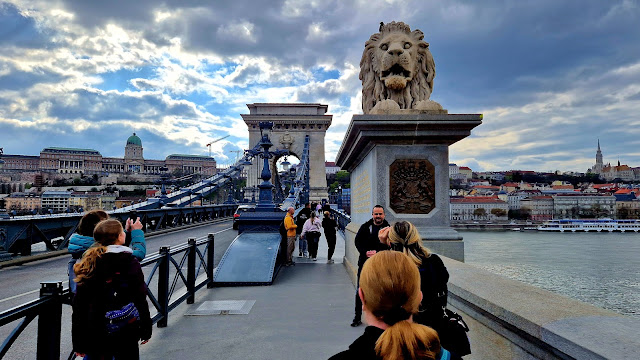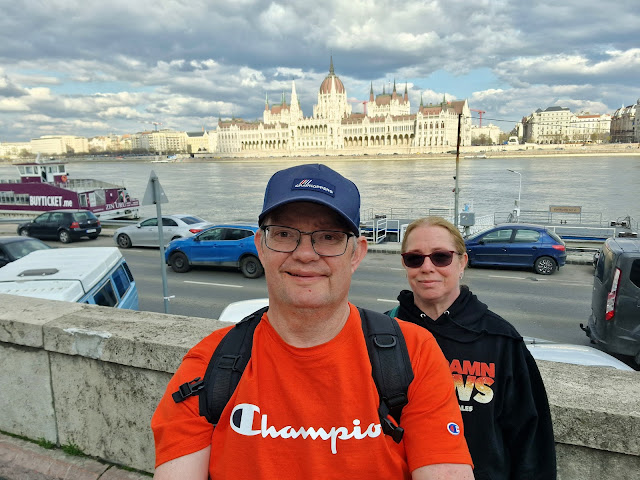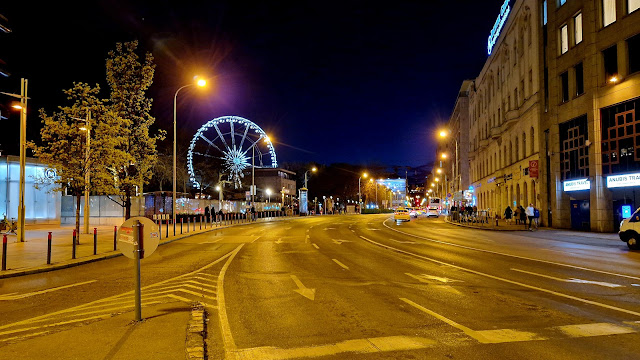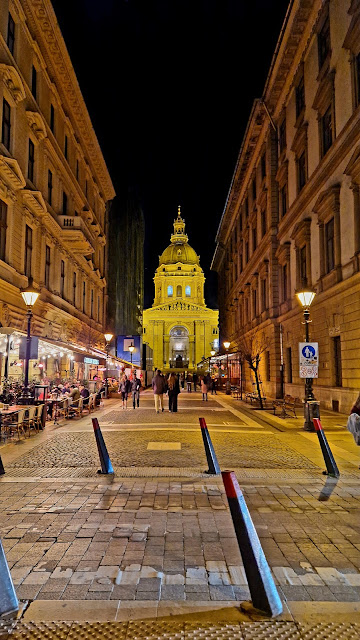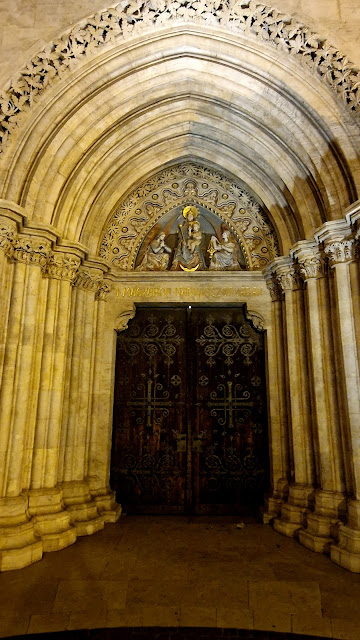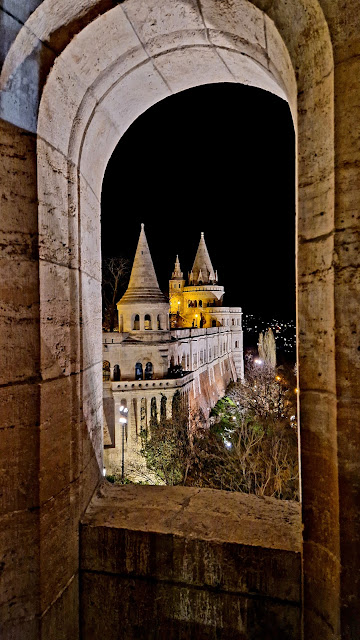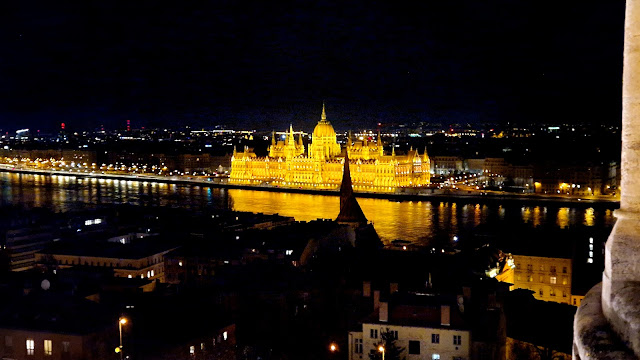On Tuesday 1st April 2025 we got up in the early hours and drove to Stansted Airport. After whizzing through security and the bag drop we were sitting around for hours, it was finally time to board our Ryanair flight to Budapest.
We landed in Budapest and took a Uber to the Star City Hotel in Istvan Utca, Budapest, and were allowed into our room early.
Afterwards we walked over to Budapest Keleti station and the cheapest option for travel for the five days here was to buy a month pass at £18.80 each, this gave us access to buses, trams, trains and the metro in the city.
We got the Metro Line 2 from Keleti-Palyaudvar to Kossuth Lajos Ter and this bought us out opposite the (Orszaghas) Hungarian Parliament building.
The Parliament is situated on Kossuth Square in the Pest side of the city, on the eastern bank of the Danube. It was designed by Hungarian architect Imre Steindl in neo-Gothic style and opened in 1902. It has been the largest building in Hungary since its completion. The architectural style of the Hungarian parliament building was influenced by the gothic Vienna City Hall, and the renaissance elements like the cupola was influenced by the Maria vom Siege church in Vienna.
Budapest was united from three cities in 1873, namely Buda, Óbuda, and Pest. Seven years later, the Diet resolved to establish a new, representative parliament building, expressing the sovereignty of the nation. The building was planned to face the Danube River. An international competition was held, and Imre Steindl emerged as the victor; the plans of two other competitors were later also realized in the form of the Ethnographic Museum and the Hungarian Ministry of Agriculture, both facing the Parliament Building. One reason that Steindl's proposal was chosen is that his neo-Gothic plans bore a strong resemblance with the Palace of Westminster in London. Leading Hungarian politicians of the 19th century found it extremely important that the country's new parliament building should symbolise their commitment to Western Europe, especially Britain, the country Hungarian reformers considered a political role model. Construction from the winning plan was started in 1885, and the building was inaugurated on the presumed 1,000th anniversary of the country in 1896. With the keys to the building being handed over in 1902, it was however not fully completed until 1904, after which 40 million bricks, half a million precious stones and 40 kg (88 lb) of gold were used. The architect of the building first went blind and later died before the building's completion.
Since World War II, the legislature has been unicameral, and today the government uses only a small portion of the building, with the other wing occasionally serving to house events. During the People's Republic of Hungary, a red star perched on the top of the dome, but it was removed in 1990 after the fall of communism. Mátyás Szűrös declared the Hungarian Republic from the balcony facing Kossuth Lajos Square on 23 October 1989.
The Parliament Building is built in the Gothic Revival style; it has a symmetrical façade and a central dome. The dome is Renaissance Revival architecture. The parliament is also largely symmetrical from the inside, with two identical parliament halls on the opposing sides of the building. One of the two halls is still in use today for sessions of the Hungarian National Assembly, the other for ceremonies, conferences, and guided tours. It is 268 m (879 ft) long and 123 m (404 ft) wide, making it the largest building in the country since its construction. Its interior includes 10 courtyards, 13 passenger and freight elevators, 27 gates, 29 staircases and 691 rooms (which includes more than 200 offices). Its height of 96 m (315 ft) is an allusion to the purported nation's millennium in 1896, with the establishment of the Principality of Hungary in 896 following the Hungarian conquest of the Carpathian Basin. It was one of the two tallest buildings in Budapest, along with Saint Stephen's Basilica, until the MOL Campus topped out in 2021.
The main façade overlooks the Danube, but the official main entrance is from the square on the east side of the building. Inside and outside, there are altogether 242 sculptures on the walls. The façade displays statues of Hungarian rulers, Transylvanian leaders, and famous military figures. The coats of arms of kings and dukes are depicted over the windows. The eastern staircase is flanked by two lions. When entering the Parliament Building, visitors can walk up great ornamental stairs, see frescoes on the ceiling, and pass by the bust of the architect Imre Steindl in a wall niche. Other statues include those of Árpád, Stephen I and John Hunyadi. The building features stained glass and glass mosaics by Miksa Róth.
One of the most famous parts of the building is the hexadecagonal (sixteen-sided) central hall, with huge chambers adjoining it: the Lower House and the Upper House. The modern National Assembly is unicameral and meets in the Lower House, while the Upper House is used as a conference and meeting room. The Holy Crown of Hungary, which is also depicted in Hungary's coat of arms, has been displayed in the central hall since 2000. Due to its extensive surface and detailed handiwork, the building is almost always under renovation.
We walk over to the River Danube.
The Danube is the second-longest river in Europe, after the Volga in Russia. It flows through Central and South-Eastern Europe, from the Black Forest south into the Black Sea. A large and historically important river, it was once a frontier of the Roman Empire. In the 21st century, it connects ten European countries, running through their territories or marking a border. Originating in Germany, the Danube flows southeast for 2,850 km (1,770 mi), passing through or bordering Austria, Slovakia, Hungary, Croatia, Serbia, Romania, Bulgaria, Moldova, and Ukraine. Among the many cities on the river are four national capitals: Vienna, Bratislava, Budapest, and Belgrade.
We walk over to a statue of Attila József Statue that sits between Parliament and the river.
Sitting on stairs, the poet is staring at the river.
A crumpled coat lies at his side, possibly a reference to one of his poems, Sárga füvek, Yellow Grass, where he likens his country to an “eladott kabát”, a peddled coat. A symbolic image that appears even stronger due to the statue’s proximity with the Parliament building, one of the greatest landmarks and symbols of the Hungarian nation.
Nevertheless, this sculpture is said to have been inspired by another one of his poems, By the Danube. And despite the contradictions of his life and tragedy, let us simply be led and swept away by his poetic art: “Én úgy vagyok, hogy már százezer éve/nézem, amit meglátok hirtelen”. In other words, let us feel like “the one who gazed for a hundred thousand years what he sees now for the first time – thanks to his poetry”.
Every year, Poetry Day – költészet napja – is celebrated in Hungary on April 11, a date chosen to honour the memory of one of the country’s greatest poets: Attila József, born on that same day exactly 115 years ago.
Attila József was one of the poets, along with the likes of Endre Ady or Miklos Radnóti, who defined modern Hungarian poetry.
During his short life, from the turn of the 20th century to the late 1930’s, he revolutionized poetic writing, addressing in his prolific work everyday topics as much as politics, odes and celebrations of love or calls for revolutionary upheaval.
We cross the tramline and walk along the river to the Shoes on the Danube Bank.
The Shoes on the Danube Bank (Hungarian: Cipők a Duna-parton) is a memorial erected on 16 April 2005, in Budapest, Hungary. Conceived by film director Can Togay, he created it on the east bank of the Danube River with sculptor Gyula Pauer to honour the Jews who were massacred by fascist antisemitic Hungarian militia belonging to the Arrow Cross Party in Budapest during the Second World War. They were ordered to take off their shoes (shoes were valuable and could be stolen and resold by the militia after the massacre), and were shot at the edge of the water so that their bodies fell into the river and were carried away. The memorial represents their shoes left behind on the bank.
"The composition titled 'Shoes on the Danube Bank' gives remembrance to the 3,500 people, 800 of them Jews, who were shot into the Danube during the time of the Arrow Cross terror. The sculptor created sixty pairs of period-appropriate shoes out of iron. The shoes are attached to the stone embankment, and behind them lies a 40-meter-long, 70 cm high stone bench. At three points are cast iron signs, with the following text in Hungarian, English, and Hebrew: "To the memory of the victims shot into the Danube by Arrow Cross militiamen in 1944–1945. Erected 16 April 2005."
We walk along the river further towards the Széchenyi Chain Bridge.
After a brief look at the bridge we head back inland and walk up Zrinti St with views up to St Stephens Basilica.
We find 'The Policeman' Statue. A famous one and had to wait for a few to disappear before we could grab a photo.
With its jovial expression and rotund figure, the Fat Policeman Statue serves as a beacon of warmth and humour in the bustling city. It’s a playful representation that captures the heart of Budapest’s lively spirit, inviting visitors to engage in a moment of light-heartedness amidst their explorations.
It has become a popular tradition for tourists to rub the statue’s belly for good luck and to ensure their return to Budapest. This practice has given the statue’s belly a shiny patina, contrasting with the darker bronze of the rest of the sculpture.
We reach St Stephen's Basilica and stop for photos.
St. Stephen's Basilica is a Roman Catholic basilica in Budapest, Hungary. It is named in honour of Stephen, the first King of Hungary (c. 975–1038), whose right hand is housed in the reliquary.
Since the renaming of the primatial see, it has been the co-cathedral of the Roman Catholic Archdiocese of Esztergom-Budapest. Today, it is the third largest church building in present-day Hungary. It is the largest church in Budapest and a significant historical landmark within the city's UNESCO World Heritage Site Buffer Zone.
The site was the location of the Hetz-Theatre, noted for hosting animal fights. János Zitterbarth of the newly formed district built a temporary church there. In the late 1810s, about a thousand people formed the Lipótváros Parish and began fundraising and making plans for the future church. During a devastating flood in 1838 the high ground here provided a measure of safe refuge to the residents, who, in thanksgiving, subsequently donated toward the construction of the church.
At first, the building was supposed to be named after Saint Leopold, the patron saint of Austria, but was later changed to honour Saint Stephen I of Hungary, the first King of Hungary (c. 975–1038), whose mummified right hand is housed in a reliquary. In 1931, Pope Pius XI awarded it the title of basilica minor; and served as the main venue for the 34th International Eucharistic Congress in May 1938.
Although the church suffered serious damage during World War II the cellar provided shelter for many refugees and a valuable collection of the Hungarian National Archives.
Saint Stephen's is the most important church building in Hungary, one of the most significant tourist attractions and the third highest church in Hungary. The dome can be accessed either by elevator or 364 steps for a panoramic view.
A Christmas fair is held in the square in front of the basilica during the Advent season, and at that time of the year the façade is decorated with special light paintings in the evenings.
Part of the 2016 movie Inferno was filmed in St. Stephen Square in front of the basilica.
We stop in Lango's and Beer opposite the Basilica and had just that for lunch, Lango with Goulash and I had a Borsodi IPA. The lango was amazing!
The area around the square began to be built up in the 18th century. Later, by the end of the 19th century, many beautiful buildings, mainly financial institutions and ministries, had grown there. However, with their appearance they could compete with the palaces. Until the 18th century on the site of the square there was a cemetery. But with the growth of the city it was abolished, and the park, which often held fairs was destroyed. In 1858, the square received its current name, in honour of the Empress, the wife of the ruler of Austria-Hungary, Franz Josef, Elisabeth of Bavaria (also known as Sisi). In the days of socialism, the square bore the name of Stalin (1946-1953), and the name of Engels (1953-1990). In 1990, it was given the original name Erzsébet.
We walked back to the river and back to the Széchenyi Chain Bridge.
The Széchenyi Chain Bridge is a chain bridge that spans the River Danube between Buda and Pest, the western and eastern sides of Budapest, the capital of Hungary. Designed by English engineer William Tierney Clark and built by Scottish engineer Adam Clark, it was the first permanent bridge across the Danube in Hungary. It was opened in 1849. It is anchored on the Pest side of the river to Széchenyi Square (formerly Roosevelt Square), adjacent to the Gresham Palace and the Hungarian Academy of Sciences, and on the Buda side to Adam Clark Square, near the Zero Kilometre Stone and the lower end of the Castle Hill Funicular, leading to Buda Castle.
The bridge bears the name of István Széchenyi, a major supporter of its construction, but is most commonly known as the "Chain Bridge". At the time of its construction, it was regarded as a marvel of modern engineering. Its decorations are made of cast iron.
The bridge was designed by English engineer William Tierney Clark in 1839, following an initiative by Count István Széchenyi, with construction supervised locally by Scottish engineer Adam Clark (no relation). It is a larger-scale version of Tierney Clark's earlier Marlow Bridge, across the River Thames in Marlow, England, and was designed in sections and shipped from the United Kingdom to Hungary for final construction.
It was funded to a considerable extent by the Greek merchant Georgios Sinas who had financial and land interests in the city and whose name is inscribed on the base of the south-western foundation of the bridge on the Buda side.
The bridge opened in 1849, after the Hungarian Revolution of 1848, becoming the first permanent bridge in the Hungarian capital. At the time, its centre span of 202 metres (663 ft) was one of the largest in the world. The lions at each of the abutments were carved in stone by the sculptor János Marschalkó and installed in 1852. The bronze lions of Trafalgar Square (commissioned in 1858 and installed in 1867) are similar in design to the Chain bridge lions. The bridge was given its current name in 1898.
The bridge's cast-iron structure was updated and strengthened in 1914. In World War II, the bridge was blown up on 18 January 1945 by the retreating Germans during the Siege of Budapest, with only the towers remaining. It was rebuilt, and reopened in 1949.
The inscription on each side of the bridge is to "Clark Adam", the bridge builder's name in the local Eastern name order. A plaque on the Pest side of the river reads "To commemorate the only two surviving bridges designed by William Tierney Clark: The Széchenyi Chain Bridge over the Danube at Budapest and the suspension bridge over the Thames at Marlow, England."
The bridge was closed for traffic between March 2021 and August 2023 for renovations.
In 2001 Hungarian stunt pilot Péter Besenyei flew upside down under the bridge, a manoeuvre that became a standard in Red Bull air races today.
The bridge is featured in the films Music Box, I Spy, Au Pair, Walking with the Enemy and Spy, and is the setting of the climax in the Bollywood blockbuster Hum Dil De Chuke Sanam. The bridge appears in the opening shots of the 2021 Black Widow trailer, and season two of Baptiste.
The bridge featured prominently in Matthew Barney's Cremaster 5, serving as a reference to Harry Houdini, and also appears in Dan Brown's novel Origin and in Syfy channel's 12 Monkeys Season Two premiere episode in April 2016.
It also appears at the beginning of the video for Katy Perry's song "Firework", and K-pop vocal duo Davichi's music video for the song "Cry Again".
According to a Hungarian legend, the lions of Széchenyi Chain Bridge have no tongues. This legend is not true, the tongues are just not visible.
The bridge has been depicted on the Hungarian 200 Forint coin since 2012.
As we cross the bridge we get a view back across to Parliament and the river.
We walk along the river bank on the Buda side and look back to the Széchenyi Chain Bridge.
I saw two of the many Kolodko Statues dotted around the city here by the riverside.
Szilágyi Dezső Square Reformed Church: Neo-Gothic church on the Buda side of the Danube.
The Neo-Gothic church made of red bricks, is completed by a slender bell tower 62 metres high. Its roof is covered in Zsolnay glazed tiles in brown, yellow and green.
It was designed by architect Samu Pecz, who also designed the famous Central Market Hall on the Pest side. A special architectural feature of the church is its ground plan arranged around a central pentagonal shape.
 |
| View to Parliament in the sunshine. |
We reach Batthyány Tér metro station and catch the metro back to Keleti Palyaudvar Station.
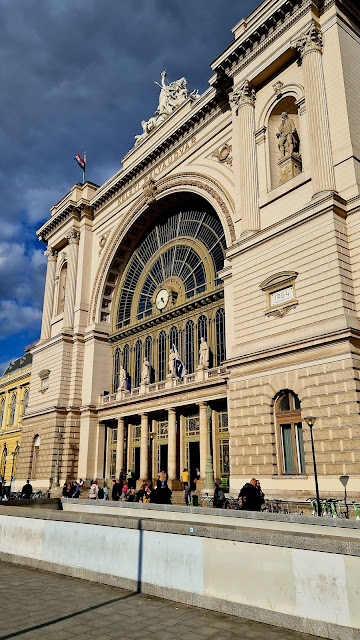 |
| Keleti Palyaudvar Station |
 |
| Star City Hotel |
We walk back to the hotel for a snooze after our early start today.
After our snooze we walk back to Keleti Palyaudvar Station and catch the metro to Deak Ferenc Ter and walk back out into Elizabeth Square.
From the Ferris wheel you will have a panoramic view of all the city's sights, from the Danube boats to the Buda Castle and the many church spires of Pest.
We walk back pass St Michael's Basilica.
We walk down Oktober 6 Utca and stop in Kisharang Etkezde and have a Goulash Soup and a Soproni beer.
We cross back across the bridge and have great views to Parliament all lit up, seen this so many times online and great to see it in person.
We decide we'll walk up to see Fisherman's Bastion tonight as it'll be great to see it lit up and views across Budapest by night.
After quite a bit of climbing up the hill, we start the last climb up the stairs to the Fisherman's Bastion.
The Halászbástya or Fisherman's Bastion is one of the best known historical monuments in Budapest, located near the Buda Castle, in the Várkerület (Buda Castle District). Since 1987, it has been designated a UNESCO World Heritage Site as part of the Várkerület District (Buda Castle District).
It offers a unique panorama of Budapest from its Neo-Romanesque lookout terraces. The Fisherman's Bastion's main façade, parallel to the Danube, is approximately 140 metres long, of which the southern aisle is about 40 metres long, the north is 65 metres long, and the ornate central parapet is 35 metres long. Its seven high-pitched stone towers symbolise the seven chieftains of the Hungarians who founded Hungary in 895.
The original walls were built in the 1700s, forming part of the walls of a castle. A consensus among historians is that in the Middle Ages this part of the castle wall was protected by the guild of fishermen (halász), who lived under the walls in the so-called Fishtown or Watertown. The current structure was built between 1895 and 1902, in Neo-Romanesque style, on the base of a stretch of the Buda Castle walls, by architect Frigyes Schulek, who was also responsible for the restoration.
The building was formerly known as the 'Fishermen's Bastion', presumably from the section of the Buda City Wall entrusted to the guild of fishermen, but more likely to the Danube side settlement, Fishtown (Halászváros) also called Watertown. The fishermen found their merchandise already in the Middle Ages. Near the Matthias Church it was brought to the fish market. The guild of fishermen not only cared for selling fish, but in wars, its members defiantly defended the city walls.
 |
| Statue of St. Stephen I |
The statue of Saint Stephen has been standing in Buda Castle next to the Fisherman's Bastion for 115 years. Although the founding king of Hungary has always been highly respected in the country, the great work of Alajos Strobl was completed slowly. The first statue of King Stephen in Budapest was inaugurated in 1906 next to Matthias Church almost 40 years after it was first planned.
The cult surrounding Saint Stephen has always been strong in Hungary, and his feast day, also known as the State Foundation Day, is one of the greatest holidays in the country. In light of this, it is interesting that Hungary's founding king did not have a worthy statue in Budapest until the beginning of the 20th century.
 |
| Mattias Church aka The Church of Our Lady of Buda Castle. |
Next to the Fisherman's Bastion is Mattias Church.
The Church of the Assumption of the Buda Castle , more commonly known as the Matthias Church and more rarely as the Coronation Church of Buda, is a Catholic church in Holy Trinity Square, Budapest, Hungary, in front of the Fisherman's Bastion at the heart of Buda's Castle District.
According to church tradition, it was originally built in Romanesque style in 1015, although few references exist. The current building was constructed in the florid late Gothic style in the second half of the 14th century and was extensively restored in the late 19th century. It was the second largest church of medieval Buda and the seventh largest church of the medieval Hungarian Kingdom. It is a historic building with an important history. The last two Kings of Hungary were crowned within its walls: Franz Joseph I of Hungary, and Charles IV of Hungary .
The church was also the location of the "Marian Miracle" of Buda. In 1686, during the siege of Buda by the Holy League, a wall of the church - used as a mosque by the Ottoman occupiers of the city - collapsed due to cannon fire. It turned out that an old votive Madonna statue was hidden behind the wall. As the sculpture of the Virgin Mary appeared before the praying Muslims, the morale of the Muslim garrison collapsed and the city fell on the same day.

The Castle Hill served as a lodging and fortification for the surrounding settlements at the time of the kings of Árpád dynasty. The development of the settlement on the Castle Hill for King Béla IV of Hungary became more prominent as a result of urban development, but as the administrative centre of the country, it became dominant in the era of King Matthias Corvinus. Its defences and bastions were fortified in the Middle Ages and during the Turkish occupation, but were repeatedly damaged. The Buda Castle Quarter itself has undergone a major transformation over time. From Matthias' bright, was prosperous the Buda Castle but following the Mohács Disaster during the Turkish rule destroyed, abolished and transformed many things and in the Castle as well. The Austrian forces retook the city from the Turks ruling from Vienna.
It is based on the basement walls of today's Fisherman's Bastion, from the tower of the former Híradás (Telegraph) to the Jezsuita lépcső (Jesuit stairs), following the folded layout of the former bastion. This folded castle wall protection system breaks the bastion line so that each section can protect each other with a side fire. This section was built after the defeat of the Rákóczi's War of Independence by Austrian Command, according to what was then a modern military principle. The northern lobby tower of today's Fisherman's Bastion, was erected on the site of the circular tower.
The Fisherman's Bastion gradually deteriorated despite the renovation of some of its defences and the rebuilding of Austrians, which was recognised by the Austrian military leadership as a military fortress. The Fisherman's Bastion was spared neither by nature nor by the wars. Rain from the mountain loosened, washing away some of the foundations of the castle wall and the Bastion on the hillside. At the same time, in memory of recent wars, many of them had traces of good or bad restoration of the rocks of ball-dart gaps. At the same time, the area rises far above the city and was of decisive importance for the cityscape. However, the Austrian military leadership refused to spend more money on settling the area than would be required for a more prominent fortification, so they only performed the fortification. The fortress character of the Buda Castle was abolished in 1874 when the Ministry of War declared that the Castle as a fortress did not meet the requirements considered modern at that time. From now on, these repairs were also cancelled. While handling the matter in the capital, he had already dealt with the reassuring settlement of the area. Already in 1871 the Pest Committee on Beauty has launched a call for the development of regulatory plans for the newly merged capital. All three winners of the competition dealt with the issue of the settlement of the Castle Hill, and within this the Fisherman's Bastion was given special emphasis.
The Fisherman's Bastion is due to its architectural and urban planning tasks related to the restoration of Matthias Church. In his summary of the architect Frigyes Schulek, which has done so much to protect and renew the Medieval temples, he has already recognised that the church was once lacking in money and with its peculiar and slightly depressed proportions from a military point of view (it was not possible for its tall, towering tower to be a reference), the lower soil level achieved by the excavation and the environment should be maintained. After the completion of the renewal of the Matthias Church, the question of restoring the environment and making it worthy of the temple became urgent. According to the original ideas, this area should have been organised for the millenary anniversary of the Hungarian state, when the first Hungarian King was crowned, and although it was drafted in Schulek's time and submitted to the Public Works Council of the Capital, in 1894 it was consulted, the construction was eventually limited to 1899 and started in several instalments. In 1901 and 1902, the southern and northern stairs were completed, but the entire Fisherman's Bastion was completed after the construction was completed, 1905. On the 9th of October it was handed over to the capital.
The implementation of the Fisherman's Bastion and its original appropriation differed, mainly because of a change in the basic concept of the millennium celebration. The first budget appropriation for the construction of the Fisherman's Bastion was of 800,000 forints at that time, of which 100,000 for the stairs, 200,000; for the corridors, 200,000; for the planned St Stephen's Hall. and 300,000 forints for the Seven chieftains halls. The latter idea was highlighted in the plan and elsewhere, on the Pest side of the City Park, at the end of what was then Sugár Road, in today's Heroes Square was realised according to the ideas of Millennium Monument not of Schulek, but of Albert Schickedanz and sculptor György Zala. In the meantime, the cost of another statue of St Stephen and the Millennium Monument has been deducted. In the end, total construction cost was of 1,165,000 forints; of which the stairs and associated landscaping costs, 200,000 forints; were covered by the Metropolitan Public Works Council, and the rest were shared between the capital (685 and 1,000 forints) (280,000).
The roof of Matthias Church in Budapest is known for its distinctive, colourful glazed tiles, creating a unique and striking architectural feature. These tiles, featuring a diamond pattern, were added during a major restoration in the late 19th century under the guidance of architect Frigyes Schulek. The restoration aimed to recreate the church's original 13th-century appearance, and the colourful tiles were a controversial but defining element of the project.
The Fisherman's Bastion was severely damaged during the sieges of World War II, but since it was one of the important landmarks of Budapest, it occupied a prominent place in the restoration priorities after the war. The restoration work was led by László Bors, a state-appointed architect. The restoration was made more difficult by the fact that firefighters had to thoroughly inspect the area centimeter by centimeter before the damage assessment and restoration plans could be completed. The restoration of the Fisherman's Bastion after World War II, was completed in 1953.
On 30 May 1995 the Castle District introduced an entry fee for the Fisherman's Bastion. In November 2003, the building complex was handed over to the public.
This staircase leads to the dedicated hall of Hungarian faith and to the memories of Hungarian glory, inspired by the faith and memories of the great past in the artistically crafted stones of the Coronation Main Church of Budavár and the exalted convert of the Fisherman's Bastion. Hungarian, you are on this step remember: Our nation is made strong by the unity of faith and patriotism.
— Text from a Fisherman's Bastion Construction stone.
Schulek originally intended to build three-stage staircases reaching the Danube. Until the Fisherman's Bastion was built, in the place was a long stretch of narrow and dark Jesuit stairs, which reached the southern wall of the bastion. It was possible to access the Jesuit stairs from the Fishtown, which was unsuitable for major, larger traffic. Schulek altered the gateway, widening the stairs to 8 metres in some places, and its lower gate was accentuated with a stylish gable, incorporating an original lionic relief from a Romanesque church excavated during the rampart work. Simple stairs made of granite stone are placed on a brick foundation, and only the so-called "stairs" used on the railings were used. It was decorated with truncated, pierced forms with Romanian style features. On the right and left of the staircase, a statues of warriors representing different weaponry of the 10th century Árpád age were placed guarding the gate (at the top of the stairs, under the arch). Four of the seven leading statues on the main stairs were carved by Franz Graf Mikhail (Ferenc Mikula 1861–1926), a sculptor born in Debrecen and educated in Vienna. Also he made the pedestal, the lions and the reliefs of the statue of St. Stephen.
Next to the Bastion and Matthias Church was a building guarded by Police, I asked them what building it was. its apparently a Government building.
The Bastions's seven towers represent the seven Magyar tribes that settled in the Carpathian Basin in 895. From the towers and the terrace there is a panoramic view over the Danube, the Margaret Island, the Gellért Hill and Pest (sometimes even further East).
A bronze statue of Stephen I of Hungary mounted on a horse, erected in 1906, can be seen between the Bastion and the Matthias Church. The pedestal was made by Alajos Stróbl, based on the plans of Frigyes Schulek, in Neo-Romanesque style, with episodes illustrating the King's life.
Near the bastion there is a lookout-terrace with numerous stairs and walking paths.
The building was featured as a Pit Stop on the sixth season of American TV show The Amazing Race.
Matthias church has 7 bells. Six of them are located in the bell tower and the last damaged bell hangs in the cavalry tower. Three of the tower's bells are historic bells (from years 1723, 1724 and 1891). The church received four new bells in 2010, and at that time the St. Károly bell sound correction took place.
Views across to Parliament was worth the climb up alone!
Amazing up here. I look up that we can get a bus back to Deak Ferenc Metro and then this back to Keleti Palyaudvar, where we walk back to our hotel for the night.






















